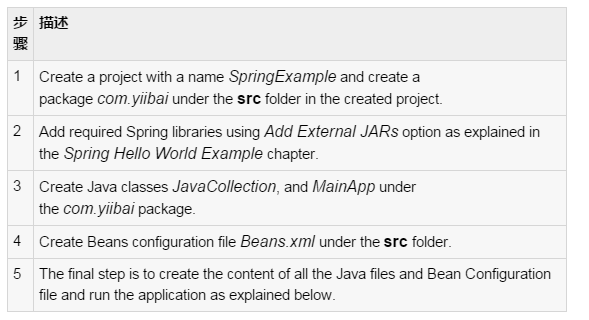使用value属性和使用<property>标签的ref属性在你的bean配置文件中的对象引用,这两种情况下可以处理单值到一个bean,如果你想通过多元值,如Java Collection类型List, Set, Map 及 Properties。要处理这种情况,Spring提供了四种类型的如下集合的配置元素:

可以使用<list> 或<set> 来连接任何实现java.util.Collection或数组。
会遇到两种情况(a)将收集的直接的值及(b)传递一个bean的引用作为集合的元素之一。
例子:
我们使用Eclipse IDE,然后按照下面的步骤来创建一个Spring应用程序:

这里是JavaCollection.java文件的内容:
|
1
2
3
4
5
6
7
8
9
10
11
12
13
14
15
16
17
18
19
20
21
22
23
24
25
26
27
28
29
30
31
32
33
34
35
36
37
38
39
40
41
42
43
44
45
46
47
48
49
50
|
package com.yiibai;import java.util.*;public class JavaCollection { List addressList; Set addressSet; Map addressMap; Properties addressProp; // a setter method to set List public void setAddressList(List addressList) { this.addressList = addressList; } // prints and returns all the elements of the list. public List getAddressList() { System.out.println("List Elements :" + addressList); return addressList; } // a setter method to set Set public void setAddressSet(Set addressSet) { this.addressSet = addressSet; } // prints and returns all the elements of the Set. public Set getAddressSet() { System.out.println("Set Elements :" + addressSet); return addressSet; } // a setter method to set Map public void setAddressMap(Map addressMap) { this.addressMap = addressMap; } // prints and returns all the elements of the Map. public Map getAddressMap() { System.out.println("Map Elements :" + addressMap); return addressMap; } // a setter method to set Property public void setAddressProp(Properties addressProp) { this.addressProp = addressProp; } // prints and returns all the elements of the Property. public Properties getAddressProp() { System.out.println("Property Elements :" + addressProp); return addressProp; }} |
以下是MainApp.java文件的内容:
|
1
2
3
4
5
6
7
8
9
10
11
12
13
14
15
16
17
18
|
package com.yiibai;import org.springframework.context.ApplicationContext;import org.springframework.context.support.ClassPathXmlApplicationContext;public class MainApp { public static void main(String[] args) { ApplicationContext context = new ClassPathXmlApplicationContext("Beans.xml"); JavaCollection jc=(JavaCollection)context.getBean("javaCollection"); jc.getAddressList(); jc.getAddressSet(); jc.getAddressMap(); jc.getAddressProp(); }} |
以下是配置文件beans.xml文件里面有配置的集合的所有类型:
|
1
2
3
4
5
6
7
8
9
10
11
12
13
14
15
16
17
18
19
20
21
22
23
24
25
26
27
28
29
30
31
32
33
34
35
36
37
38
39
40
41
42
43
44
45
46
47
48
49
50
51
52
53
|
<?xml version="1.0" encoding="UTF-8"?><beans xmlns="http://www.springframework.org/schema/beans" xmlns:xsi="http://www.w3.org/2001/XMLSchema-instance" xsi:schemaLocation="http://www.springframework.org/schema/beans http://www.springframework.org/schema/beans/spring-beans-3.0.xsd"> <!-- Definition for javaCollection --> <bean id="javaCollection" class="com.yiibai.JavaCollection"> <!-- results in a setAddressList(java.util.List) call --> <property name="addressList"> <list> <value>INDIA</value> <value>Pakistan</value> <value>USA</value> <value>USA</value> </list> </property> <!-- results in a setAddressSet(java.util.Set) call --> <property name="addressSet"> <set> <value>INDIA</value> <value>Pakistan</value> <value>USA</value> <value>USA</value> </set> </property> <!-- results in a setAddressMap(java.util.Map) call --> <property name="addressMap"> <map> <entry key="1" value="INDIA"/> <entry key="2" value="Pakistan"/> <entry key="3" value="USA"/> <entry key="4" value="USA"/> </map> </property> <!-- results in a setAddressProp(java.util.Properties) call --> <property name="addressProp"> <props> <prop key="one">INDIA</prop> <prop key="two">Pakistan</prop> <prop key="three">USA</prop> <prop key="four">USA</prop> </props> </property> </bean></beans> |
创建源代码和bean配置文件完成后,让我们运行应用程序。如果应用程序一切顺利,这将打印以下信息:
|
1
2
3
4
|
List Elements :[INDIA, Pakistan, USA, USA]Set Elements :[INDIA, Pakistan, USA]Map Elements :{1=INDIA, 2=Pakistan, 3=USA, 4=USA}Property Elements :{two=Pakistan, one=INDIA, three=USA, four=USA} |
注入Bean引用:
下面bean定义将帮助您了解如何注入bean的引用作为集合的元素之一。甚至可以混合引用和值都在一起,如下图所示:
|
1
2
3
4
5
6
7
8
9
10
11
12
13
14
15
16
17
18
19
20
21
22
23
24
25
26
27
28
29
30
31
32
33
34
35
36
37
38
39
40
|
<?xml version="1.0" encoding="UTF-8"?><beans xmlns="http://www.springframework.org/schema/beans" xmlns:xsi="http://www.w3.org/2001/XMLSchema-instance" xsi:schemaLocation="http://www.springframework.org/schema/beans http://www.springframework.org/schema/beans/spring-beans-3.0.xsd"> <!-- Bean Definition to handle references and values --> <bean id="..." class="..."> <!-- Passing bean reference for java.util.List --> <property name="addressList"> <list> <ref bean="address1"/> <ref bean="address2"/> <value>Pakistan</value> </list> </property> <!-- Passing bean reference for java.util.Set --> <property name="addressSet"> <set> <ref bean="address1"/> <ref bean="address2"/> <value>Pakistan</value> </set> </property> <!-- Passing bean reference for java.util.Map --> <property name="addressMap"> <map> <entry key="one" value="INDIA"/> <entry key ="two" value-ref="address1"/> <entry key ="three" value-ref="address2"/> </map> </property> </bean></beans> |
使用上面的bean定义,需要定义这样一种方式,他们应该能够处理的参考,以及setter方法。
注入null和空字符串的值
如果需要传递一个空字符串作为值,如下所示:
|
1
2
3
|
<bean id="..." class="exampleBean"> <property name="email" value=""/></bean> |
前面的例子等同于Java代码: exampleBean.setEmail("")
如果需要传递一个null值,如下所示:
|
1
2
3
|
<bean id="..." class="exampleBean"> <property name="email"><null/></property></bean> |
前面的例子等同于Java代码:exampleBean.setEmail(null)













